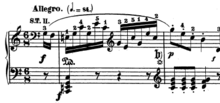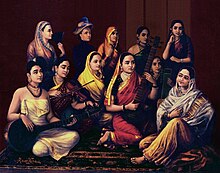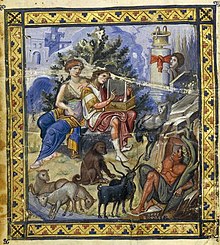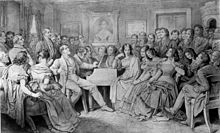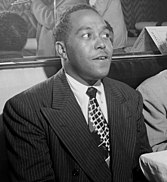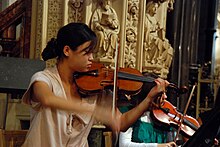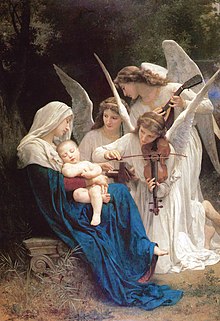Music
The music (from the Greek: μουσική [τέχνη] - mousikē [téchnē], «the art of the muses») is, according to the traditional definition of the term, the art of creating and organizing sounds and silences respecting the fundamental principles of melody, harmony and rhythm, through the intervention of complex psycho-animous processes. The concept of music has evolved since its origin in Ancient Greece, when poetry, music and dance were brought together without distinction as a unitary art. For several decades, the definition of what music is and what it is not has become more complex, since outstanding composers in the framework of various border artistic experiences have made works that, although they could be considered musical, expand the limits of the definition. of this art.
Music, like any artistic manifestation, is a cultural product with multiple purposes, among others, to provoke an aesthetic experience in the listener, to express feelings, emotions, circumstances, thoughts or ideas, and increasingly, play an important therapeutic role through music therapy.
Music plays a vital role in the cognitive development of human beings. It is related to logical mathematical thinking, language acquisition, psychomotor development, interpersonal relationships, learning non-native languages and enhancing emotional intelligence, among others. For this reason, music must be present in any modern educational plan and be recognized as an essential discipline within compulsory education.
Music is a sound stimulus that affects the individual's perceptual field; Thus, the sound flow can fulfill various functions (entertainment, communication, setting, fun, etc.). In many cultures, music is an important part of people's way of life, playing a key role in religious rituals, rite of passage ceremonies (for example, graduation and marriage), social activities (for example, in dancing) and in cultural activities ranging from amateur singing in karaoke to playing in an amateur funk band or singing in a community choir. People may make music for a hobby, such as a teenager playing the cello in a youth orchestra, or work as a professional musician or singer. The music industry includes people who create new songs and pieces of music (such as singer-songwriters and composers), people who perform music (including musicians in orchestras, jazz bands, and rock bands), singers and conductors), people who record music (music producers and sound engineers), people who organize concert tours, and people who sell recordings and sheet music to customers. Even once a song or piece has been performed, music critics, music journalism and musicology can assess and evaluate the piece and its performance.
Etymology
The word "music" derives from the Greek μουσική (mousike; "(art) of the muses") In Greek mythology, the nine muses were the goddesses who inspired literature, science and the arts and were the source of knowledge embodied in the poetry, songs and myths of Greek culture.
According to the Online Etymology Dictionary:
The term “music” derives from “musikemid-centuryXIIIof the old French musique (sixteenth century)XII) and directly from the Latin music "the art of music", which also includes poetry (also the source of Spanish music, Italian music, ancient German high mosica, German MusikDutch muziekDanish musik)». It derives from the “... mousike (techne) "(art) of the muses", of the female mousikos "belonging to the muses", by Mousa "Musa".
Modern spelling dates from the 1630s. In classical Greece, the term "music" refers to any art over which the muses presided, but especially music and lyric poetry.
Definition
Definitions start from within cultures, and thus, the meaning of musical expressions is affected by psychological, social, cultural and historical issues. In this way, multiple and diverse definitions arise that may be valid when expressing what is meant by music. None, however, can be considered perfect or absolute.
A fairly broad definition determines that music is organized loudness (according to a perceptible, coherent and meaningful formulation). This definition is based on the fact that —in what can be consensually called «music»– certain patterns of the «sound flow» can be perceived depending on how the properties of sound are learned and processed by humans (there are even those who consider that also for animals). The definition attributed to Edgard Varese of music as organized sound, and also that of the Encyclopedia Britannica which in its 15th edition describes that "although there are no sounds that cannot be described as inherently non-musical, in every culture the musicians they have tended to restrict the range of sounds they were willing to admit." John Blacking added this important detail to Varèse's definition: "music is humanly organized sound".
Today it is common to work with a concept of music based on three essential attributes: that it uses sounds, that it is a human product (and in this sense, artificial) and that the aesthetic function predominates. If we took into account only the first two elements of the definition, nothing would differentiate music from language. As for the "aesthetic" function, this is a rather debatable point; Thus, for example, an advertising jingle does not stop being music because it fulfills a non-aesthetic function (trying to sell merchandise). On the other hand, speaking of an "aesthetic" function presupposes an idea of music (and of art in general) that functions autonomously, outside the functioning of society, as we see it in the theory of art of the philosopher Immanuel Kant..
Jean-Jacques Rousseau, author of the musical voices in Diderot's L'Encyclopédie, later collected in his Dictionnaire de la Musique, defined it as the "art of combining sounds in a way pleasing to the ear".
According to the composer Claude Debussy, music is “a total of dispersed forces expressed in a sound process that includes: the instrument, the instrumentalist, the creator and his work, a propagating medium and a receiving system”.
The most common definition in music manuals is quite similar to this: “music is the art of combining sounds well in time”. This definition does not stop to explain what art is, and presupposes that there are "well done" combinations and others that are not, which is at least debatable.
Some scholars have defined and studied music as a set of tones arranged horizontally (melody) and vertically (harmony). This order or structure that a group of sounds must have to be called music is, for example, present in the assertions of the German philosopher Johann Wolfgang von Goethe when he compared it to architecture, metaphorically defining architecture as “frozen music”. Most scholars agree on the aspect of structure, that is, on the fact that music implies organization; but some modern theorists differ that the result must be pleasant or agreeable.
Sound parameters
Sound is the sensation perceived by the ear when receiving the pressure variations generated by the vibratory movement of sound bodies. It is transmitted by the medium that surrounds them, which is generally the air in the atmosphere. The perceptible absence of sound is silence, although it is a relative sensation, since absolute silence does not occur in nature.
Sound has four fundamental parameters:
- The height is the result of the frequency that produces a sound body; that is, the amount of vibration cycles per second or hertz (Hz) that are issued. According to this you can define sounds as serious and sharp. The higher the frequency, the more acute (or high) the sound. The wavelength is the measured distance in the direction of propagation of the wave, between two points whose state of movement is identical; that is, they reach their maximum and minimum in the same moment.
- The duration corresponds to the time that the vibrations that produce a sound last. The duration of the sound is related to the rhythm. The duration is represented on the wave for the seconds it contains.
- The intensity is the strength with which a sound occurs; it depends on the energy. The intensity is represented in a wave by the amplitude.
- Shame is the quality that allows distinguishing the different instruments or voices even though they are producing sounds with the same height, duration and intensity. The sounds we hear are complex; that is, they are the result of a set of simultaneous sounds (all, overtones and harmonic), but that we perceive as one (fundamental sound). The bell depends on the amount of harmonics or the shape of the wave that has a sound and the intensity of each one of them, to which it is called spectra. The bell is represented in a wave by the drawing. A pure sound, such as the fundamental frequency or each overtones, is represented with a sinusoidal wave, while a complex sound is the sum of pure senoidal waves. The spectrum is a succession of vertical bars distributed along a frequency axis and representing each of the senoids corresponding to each overtone, and its height indicates the amount each provides to the resulting sound.
Elements of music

Music contains two elements: the acoustic material and the intellectual idea. The two are not juxtaposed as form and content, but are combined, in music, to form a unitary image. To become a vehicle for the intellectual idea, the acoustic material undergoes a pre-musical preparation, through a process of selection and ordering.
The structure of sound, the scale of harmonic sounds, already exhibits an ordering that predestines it to be the vehicle of intellectual intention. For the purpose of a prior general understanding, within the acoustic material for the organization of music, we find various classifications, within which the most common in academic environments is the one that divides music into melody, harmony and rhythm. The manner in which these principles are defined and applied vary from culture to culture (there are also temporal variations).
- Melody is a set of sounds—conceived within a particular sound environment—that sound successively one after another (horizontal conception), and which is perceived with identity and sense of its own. The silences are also part of the structure of the melody, pausing the "melodic discourse". The result is like a well-built phrase semantically and grammatically. It is debatable—in this sense—if a Dominican sequence could be considered a melody or not. When there are two or more simultaneous melodies it is called counterpoint.
- Harmony, under a vertical conception of sound, and whose basic unit is the chord or triad, regulates the concordance between sounds that sound simultaneously and its link with neighbouring sounds.
- The rhythm, is the final result of the previous elements, sometimes with very notorious variations, but in a very general appreciation it is the ability to generate contrast in music, this is caused by the different dynamics, bells, textures and sounds. In practice it refers to the accentuation of the sound and the temporary distance between the beginning and the end of it or, otherwise said, its duration.
- The joint refers to how a sound is executed, as well as the transition between two (or more) notes. Among the varied forms of articulation elaborated throughout history, the main emphasis is the legato, the staccato, the portato, the Tight., the accent, the mark and the broth.
On the other hand, the intellectual idea (we can include what we now call brain-body-mind) converts the acoustic material into art, and thus music acquires history, linking itself with time and becoming timeless.
The incorporation of an expanded acoustic material in the XX century, sometimes produced information difficulties, due to lack of a valid system of prior understanding, and that is why other elements are taken into account when analyzing and studying the phenomenon of music, such as form, instrumentation, texture, etc. From all these elements, new ordering principles and possibilities of composition originate.
History
Prehistory
Prehistoric music can only be theorized on the basis of findings from Paleolithic archaeological sites. Bone-carved flutes are often discovered with side holes drilled into them; it is believed that they were blown into one end like the Japanese shakuhachi. Carved from the femur of a cave bear, Divje Babe's flute is thought to be at least 40,000 years old. Instruments such as the seven-hole flute and various types of stringed instruments, such as the ravanahatha, have been recovered from archaeological sites of the Indus Valley Civilization. India has one of the oldest musical traditions in the world; references to Indian classical music (marga) are found in the Vedas, ancient scriptures of the Hindu tradition. The oldest and largest collection of prehistoric musical instruments was found in China and dates to between 7000 and 6600 B.C. The "Hurrian Hymn to Nikkal", found on clay tablets dating back to about 1400 BC. C., is the oldest surviving written musical work.
Ancient Egypt
The ancient Egyptians credited one of their gods, Thoth, with the invention of music, and Osiris, in turn, used it as part of his effort to civilize the world. The earliest material and representative evidence of Egyptian musical instruments dates from the Predynastic period, but evidence is most securely attested in the Old Kingdom when harps, flutes, and double clarinets were played. During the Middle Kingdom percussion instruments, percussion instruments, were added. lyres and lutes to the orchestras. Cymbals often accompanied music and dance, as they still do in Egypt today. Egyptian folk music, including traditional Sufi dhikr rituals, is the closest contemporary musical genre to the music of ancient Egypt and has retained many of its characteristics, rhythms and instruments.
Asian Cultures
Indian classical music (marga) is one of the oldest musical traditions in the world. The Indus Valley civilization has sculptures showing dance and ancient musical instruments, such as the flute. seven holes. Various types of Harappan and Mohenjo-Daro stringed instruments and drums have been recovered through excavations by Mortimer Wheeler. The Rigveda has elements of modern Indian music, with musical notation denoting meter and manner of singing. Indian classical music is monophonic and is based on a single melodic line or raga, rhythmically organized through talas. Ilango Adigal's Silappadhikaram provides information on how new scales can be formed by modal shifting the tonic of an existing scale. Current Hindi music was influenced by Persian folk music and Afghan Mughals. Carnatic music, popular in the southern states, is largely devotional; most of the songs are addressed to Hindu deities. There are also many songs that emphasize love and other social issues.
Chinese classical music, the traditional art or court music of China, has a history dating back some three thousand years. It has its own unique systems of music notation, as well as musical pitch and pitch, instruments, and musical styles or musical genres. Chinese music is pentatonic-diatonic, with a scale of twelve notes to one octave (5 + 7 = 12) just like European-influenced music.
References in the Bible
Knowledge of the biblical period comes primarily from literary references in the Bible and post-biblical sources. Music and religion historian Herbert Lockyer wrote that "music, both vocal and instrumental, was well cultivated among the Hebrews, New Testament Christians, and the Christian church through the centuries." He adds that "a look at the Old Testament reveals how God's ancient people devoted themselves to the study and practice of music, which occupies a unique place in the historical and prophetic books, as well as in the Psalter."
Music and drama scholars studying the history and anthropology of early Semitic and Judeo-Christian culture have discovered common links in theatrical and musical activity between the classical cultures of the Hebrews and those of the later Greeks and Romans. The common area of action is in a "social phenomenon called litany", a form of prayer that consists of a series of invocations or supplications. The Journal of Religion and Theatre notes that among the earliest forms of litany, "the Hebrew litany was accompanied by a rich musical tradition":
Genesis 4.21 indicated that Jubal is the "father of all such as handle the harp and pipe", the Pentateuch is nearly silent about the practice and instruction of music in the early life of Israel. In I Samuel 10, there are more depictions of "large choirs and orchestras". These large ensembles could only be run with extensive rehearsals. This had led some scholars to theorize that the prophet Samuel led a public music school to a wide range of students.The Genesis 4.21 indicated that Jubal is the “father of all who handle the harp and flute”, the Pentateuco He is almost silent about the practice and instruction of music in the early life of Israel. In I Samuel 10, there are more representations of "large choirs and orchestras". These large sets could only be executed with extensive tests. This had led some scholars to theorize that the prophet Samuel led a public music school for a wide range of students.
Ancient Greece
Music was an important part of social and cultural life in Ancient Greece. Musicians and singers played a prominent role in Greek theatre. Performances by mixed choirs were performed for entertainment, celebration, and spiritual ceremonies. Instruments included the double-reed aulos and a string instrument. plucked string, the lyre, mainly of the special type called kithara. Music was an important part of education and children were taught music from the age of six. Greek musical literacy created a flowering of musical development. Greek music theory included Greek musical modes, which eventually became the basis for Western classical and religious music. Later, influences from the Roman Empire, Eastern Europe, and the Byzantine Empire changed Greek music. The Epitaph of Sicilus is the oldest surviving example of a complete musical composition, including musical notation, from anywhere in the world. The oldest surviving written work on the subject of theory musical is Harmonika Stoicheia by Aristoxenus.
Ancient Rome
The music of Ancient Rome has been part of Roman culture since the earliest times. Songs (carmen) were an integral part of almost all social events. Horace's Carmen saeculare, for example, was commissioned by Augusto and performed by a mixed choir of children in the Secular Games of 17 a. C. Music was common at funerals and the tibia (the Greek aulós), a woodwind instrument, was played at sacrifices to protect against evil influences. Influenced by ancient Greek theory, music was thought to reflect the order of the cosmos and was particularly associated with mathematics and knowledge.
Etruscan music had an early influence on the culture of the Romans. During the imperial period, the Romans brought their music to the provinces, while traditions from Asia Minor, North Africa, and Gaul became part of Roman culture.
Music accompanied performances and events in the arena, and was part of the performing arts form called pantomime (pantomimus), an early form of narrative ballet that combined expressive dance, instrumental music, and a sung libretto.
Middle Ages
The Middle Ages (476 to 1400) began with the introduction of monophonic singing (single melodic line) in Catholic Church services. Music notation has been used since ancient times in Greek culture, but in the Middle Ages, notation was first introduced by the Catholic Church so that chant melodies could be written down, to facilitate the use of the same melodies for music. religious music throughout the Catholic world. The only medieval European repertoire found in written form from before 800 is the monophonic liturgical plainchant of the Catholic Church, whose central tradition was called Gregorian chant.
Alongside these sacred music traditions, there was a vibrant tradition of secular song. Examples of composers from this period are Léonin, Perotín, Guillaume de Machaut, and Walther von der Vogelweide.
Renaissance
Music of the Renaissance (c. 1400 to 1600) focused more on secular themes, such as courtly love. Around 1450, the printing press was invented, making printed sheet music much less expensive and easier to mass-produce. The increased availability of sheet music helped spread musical styles more quickly and over a wider area. Musicians and singers often worked for the church, courts, and cities. Church choirs grew in size, and the Church continued to be an important patron of music. In the middle of the 15th century, composers wrote richly polyphonic sacred music, in which different melodic lines were simultaneously intertwined. Notable composers of this era include Josquin des Prés, Guillaume Dufay, Giovanni Pierluigi da Palestrina, Tomás Luis de Victoria, Thomas Morley, and Orlando di Lasso. As musical activity passed from the Church to aristocratic courts, kings, queens, and princes competed for the best composers. Many important composers came from the Netherlands, Belgium, and northern France. They are called Franco-Flemish composers and they held important positions throughout Europe, especially in Italy. Other countries with great musical activity were Germany, England and Spain.
Baroque
The Baroque era of music took place between 1600 and 1750, when the Baroque artistic style flourished throughout Europe and during this time music expanded in its range and complexity. Baroque music began when the first operas (solo dramatic vocal music accompanied by orchestra) were written. During the Baroque era, contrapuntal polyphonic music, in which multiple simultaneous independent melodic lines were used, remained important. German Baroque composers wrote for small ensembles including strings, brass, and woodwinds, as well as for choirs and instruments. keyboard, such as organ, harpsichord and harpsichord. Several important musical forms were defined during this period that endured into later periods when they expanded and evolved further, including the fugue, the invention, the sonata, and the concerto. The Late Baroque style was polyphonically complex and richly ornamented. Important composers of the Baroque era include Johann Sebastian Bach, Georg Friedrich Händel, Georg Philipp Telemann, and Antonio Vivaldi.
Classicism
Music of the classical period (1730 to 1820) aimed to imitate what were considered the key elements of Ancient Greek and Ancient Roman art and philosophy: the ideals of balance, proportion, and disciplined expression. The music of the classical period is lighter, clearer, and considerably simpler in texture than the baroque music that preceded it. The main style was homophony, where a prominent melody and a subordinate chord accompaniment part are clearly distinct. Classical instrumental melodies tended to be almost vocal and singable. New genres developed and the fortepiano, the forerunner of the modern piano, replaced the harpsichord and organ of the Baroque era as the main keyboard instrument, although the latter continued to be used in sacred music such as masses.
Instrumental music was given importance. It was dominated by further development of musical forms initially defined in the Baroque period: the sonata, the concerto, and the symphony. Other main types were the trio, the string quartet, the serenade, and the divertimento. The sonata was the most important and developed form. Although Baroque composers also wrote sonatas, the classical style of the sonata is completely different. All the major instrumental forms of the classical era, from string quartets to symphonies and concertos, were based on the sonata structure. The instruments played chamber music, and the orchestra became more standardized. Instead of the basso continuo group of the Baroque era, which consisted of harpsichord, organ, or lute along with various bass instruments selected at the discretion of the group leader (for example, viola, cello, theorbo, or serpent), classical chamber groups they used specified standardized instruments (for example, a string quartet would be played by two violins, a viola, and a cello). Baroque-era improvised chord playing by the continuo keyboardist or lutenist was phased out between 1750 and 1800.
One of the most important changes made in the classical period was the development of public concerts. The aristocracy still played an important role in sponsoring concerts and compositions, but now composers could survive without being the permanent employees of kings or princes. The growing popularity of classical music led to a growth in the number and types of orchestras. The expansion of orchestral concerts required the construction of large spaces for public performances. Symphonic music, including symphonies, musical accompaniment to ballet, and mixed vocal/instrumental genres, such as opera and oratorio, became more popular.
The most prominent classical composers are Carl Philipp Emanuel Bach, Christoph Willibald Gluck, Johann Christian Bach, Joseph Haydn, Wolfgang Amadeus Mozart, Ludwig van Beethoven and Franz Schubert. Beethoven and Schubert are also considered to be composers of the latter part of the classical era, as it began to move towards Romanticism.
Romanticism
Romantic music (c. 1810 to 1900) of the 19th century had many elements in common with romantic styles in literature and painting of the time. Romanticism was an artistic, literary, and intellectual movement characterized by its emphasis on emotion and individualism, as well as its glorification of the past and nature. Romantic music expanded beyond the rigid styles and forms of the classical era into more passionate and dramatic expressive pieces and songs. Romantic composers like Richard Wagner and Johannes Brahms tried to increase emotional expression and power in their music to describe deeper truths or human feelings. With symphonic poems, the composers tried to tell stories and evoke images or landscapes using instrumental music. Some composers promoted nationalist pride with patriotic orchestral music inspired by folk music. The emotional and expressive qualities of music came to prevail over tradition.
Romantic composers grew idiosyncratic and further syncretized to explore different art forms in a context of music (such as literature), history (historical figures and legends), or nature itself. Romantic love or longing was a predominant theme in many works composed during this period. In some cases, the formal structures of the classical period continued to be used (for example, the sonata form used in string quartets and symphonies), but these forms were expanded and modified. In many cases, new approaches to existing genres, forms, and functions were explored. In addition, new forms were created that were considered more suitable for the new theme. Composers continued to develop music for opera and ballet, exploring new styles and themes.
In the years after 1800, the music developed by Ludwig van Beethoven and Franz Schubert introduced a more dramatic and expressive style. In Beethoven's case, short, organically developed motifs came to replace the melody as the most significant compositional unit. Later Romantic composers such as Piotr Ilyich Tchaikovsky, Antonín Dvořák, and Gustav Mahler used more unusual chords and more dissonance to create a dramatic tension. They generated complex and often much longer musical works. During the late romantic period, composers explored dramatic chromatic alterations of tonality, such as extended chords and altered chords, which created new colors of sound. The late 19th century saw a dramatic expansion in the size of the orchestra and the Industrial Revolution helped create better instruments, creating a more powerful sound. Public concerts became an important part of affluent urban society. He also saw a new diversity in music for the stage, including operetta, musical comedy, and other forms of musical theater.
The piano was a representative instrument of this time, not only in the musical field but also in the technical one, since thanks to the advances achieved due to the Industrial Revolution its mechanism was substantially improved. In the same way that capitalism influenced the hierarchical organization of production chains, the piano was used as a tool to achieve musical expression and as an aid to composition. In this period there were important composers such as Félix Mendelssohn, Frédéric Chopin, Franz Liszt, Robert Schumann, Franz Schubert, Johannes Brahms, Edvard Grieg and Isaac Albéniz who made works for piano. Composers such as Aleksandr Skriabin, Sergei Rachmaninov and Gabriel Fauré stand out from late romanticism.
20th and 21st century
In the 19th century, one of the key ways new compositions became known to the public was through selling sheet music, which middle-class amateur music lovers played at home on their piano or other common instruments, such as the violin. With the music of the 20th century, the invention of new electrical technologies such as radio broadcasting, and the availability of gramophone records on the market Massiveness meant that sound recordings of songs and pieces heard by listeners (either on the radio or on their record player) became the main avenue for learning about new songs and pieces. There was a huge increase in music listening as radio gained popularity and phonographs were used to play and distribute music, because while in the 19th century 19th century, the focus on sheet music restricted access of new music to upper-middle-class people who could read music and owned pianos and instruments, in the XX, anyone with a radio or record player could hear operas, symphonies, and big bands in their own living room. This allowed low-income people, who could not afford a ticket to an opera or symphony concert, to hear this music. It also meant that people could listen to music from different parts of the country, as well as different parts of the world, even if they couldn't afford to travel to these places. This helped spread musical styles.
The approach to art music in the 20th century was characterized by the exploration of new rhythms, styles, and sounds. The aftermath of World War I influenced many of the arts, including music, and some composers began to explore darker, grittier sounds. Composers used traditional musical styles such as jazz and folk music as a source of ideas for classical music. Igor Stravinsky, Arnold Schönberg and John Cage were influential composers in art music of the 20th century. The invention of sound recording and the ability to edit music gave rise to a new subgenre of classical music, including schools of electronic acousmatic composition and music concrete. Sound recording was also highly influential in the development of popular music genres, because it allowed recordings of songs and bands to be widely distributed. The introduction of the multitrack recording system had a great influence on rock music, because it could do much more than record a band's performance. Using a multitrack system, a band and their music producer could overdub many layers of instrument and vocal tracks, creating new sounds that would not be possible in a live performance.
Jazz evolved into an important musical genre throughout the 20th century and through the second half of the that century, rock music did the same. Jazz is an American musical art form that originated at the turn of the century in African-American communities in the American South from a confluence of African and European musical traditions. The West African pedigree of the style is evident in the use of blues notes, improvisation, polyrhythms, syncopation, and the swing note.
Rock music is a genre of popular music that developed in the 1960s from the rock and roll of the 1950s, the rockabilly, blues, and country music. The sound of rock often revolves around electric or acoustic guitar and uses a strong backbeat set by a rhythm section. Along with the guitar or keyboards, the blues-style saxophone and harmonica are used as solo instruments. The traditional rhythm section of popular music is rhythm guitar, electric bass, and drums. Some bands also have keyboard instruments such as organ, piano, or, since the 1970s, analog synthesizers. In the 1980s, pop musicians began using digital synthesizers, such as the Yamaha DX7, electronic drum machines such as the Roland TR-808, and synth bass devices (such as the Roland TB-303) or synth bass keyboards. In the 1990s, an increasingly wide range of computerized hardware and software devices and musical instruments (for example, digital audio workstations) were used. In the 2020s, software synthesizers and computer music applications allow you to create and record various types of music, such as electronic dance music in your own home, by adding sampled and digital instruments and editing the recording digitally. In the 1990s, some bands from genres like nu metal began to include DJs in their bands. DJs create music by manipulating music recorded on turntables or CD players, using a DJ mixer.
Culture and music
All human cultures have musical manifestations. Most animal species are also capable of producing sounds in an organized way to communicate a wide variety of messages. What defines the music of men is not so much being a "correct" (or "harmonious" or "beautiful") combination of sounds in time as being a practice of human beings within a given social group.
Regardless of what the various musical practices of various peoples and cultures have in common, it is important not to lose sight of the diversity in terms of the instruments used to produce music, in terms of the ways of emitting the voice, in terms of to the ways of treating rhythm and melody, and, above all, regarding the function that music plays in different societies: the music that is heard in a religious celebration is not the same as the music that is heard in an advertisement, nor the one that is danced in a disco. Taking into consideration the functions that a certain music performs in a certain social context, we can be more precise when defining the common characteristics of music, and more respectful when approaching music that is not that of our society..
Most definitions of music only take into account some music produced during a certain period in the West, believing that its characteristics are "universal", that is, common to all human beings of all cultures and of all times.. Says Schopenhauer, "(music) affects man in such a powerful and magnificent way, that it can be compared to a universal language, whose clarity and eloquence surpasses all the languages of the earth."
Many people think that music is a "universal" language, since several of its elements, such as melody, rhythm, and especially harmony (relationship between the frequencies of the different notes of a chord) are plausible explanations. more or less mathematics, and that humans to a greater or lesser extent, are naturally trained to perceive as beautiful. Those who believe this ignore or ignore the complexity of human cultural phenomena. Thus, for example, it has been believed that harmony is a universal musical fact when in reality it is exclusive to Western music of the last centuries; or, even worse, it has been believed that harmony is exclusive to Western culture[citation needed] because it represents a more “advanced” or “superior” stage of “ music's evolution.
Another of the most singular phenomena of western (or westernized) societies is the complex division of labor that musical practice is subject to. Thus, for example, many times it is one person who composes the music, another who performs it, and a third party who collects the royalties. The idea that the person who creates the music is someone other than the person who performs it, as well as the idea that the person who listens to the music is not present in the same physical space where it is produced, is only possible in the Western society of a few centuries ago.; the most common (that is, the most "universal") is that creator and performer are the same person.
Western musical notation
Since ancient Greece (as far as Western music is concerned) there have been forms of musical notation. However, it is from the music of the Middle Ages (mainly Gregorian chant) that the musical notation system that would evolve to the current one began to be used. In the Renaissance it crystallized with the more or less definitive traits with which we know it today, although -like all languages- it has varied according to the expressive needs of the users.
The system is based on two axes: a horizontal one, which graphically represents the passage of time, and a vertical one, which graphically represents the height of the sound. The pitches are read in relation to a pentagram (from the Greek «πεντα», «penta»: five; and «γραμμa», «grama»: lines), which at the beginning has a key that has the function of attributing to one of the staff lines a certain musical note. In a staff headed by the "treble clef on the second line" we will read as sol the sound that is written on the second line (counting from the bottom), as la the sound that is written in the space between the second and third lines, as if the sound in the third line, etc. Additional lines are written for sounds outside the key. The most used keys are those of:
- do in third line (key that takes as reference to do4 of 261,63 Hz, the central dome of the piano),
- Sun second line (which refers to Sun which is one fifth above do central), and
- fa in fourth line (referred to fa That's a fifth below do central).
Musical speech is divided into equal units of time called measures: each vertical line through the staff marks the end of one measure and the beginning of the next. At the beginning of the staff there will be a fraction with two numbers; the top number indicates the number of beats each bar has; the bottom number tells us what the unit of time will be.
To write the durations, a system of figures is used: the round one (represented as a white circle), the white one (a white circle with a vertical stick called a stem), the black one (the same as the white one but with a black circle), the eighth note (same as the quarter note but with a horizontal stick starting at the tip of the stem), the sixteenth note (same as the eighth note but with two horizontal sticks), etc. Each one is worth half of its predecessor: the white one is worth half that of a round one and twice that of a black one, etc.
The figures are relative durations; To find out which figure is the unit of time in a certain score, we must look at the lower number of the time signature: if it is 1, each whole note corresponds to a beat; if it is 2, each half note will correspond to a beat; if it is 4, each beat will be represented by a quarter note, etc. Thus, a score headed by a 3
4 will be divided into bars that include three quarter notes (or six eighth notes, or one quarter note and four eighth notes, etc.); one measure of 4
8 will have four beats, each one represented by an eighth note, etc.
To represent the rests, the system has other signs that represent a whole rest, a half rest, etc.
As can be seen, the durations are established according to a binary relationship (double or half), which does not provide for subdivision by three, which will be indicated by triplets. When you want half of its duration to be added to a note or rest, a dot is placed to the right (dot). When you want the note to last, in addition to its value, another certain value, two notes are written and joined by an arcuate line called a slur.
In general, the incapacities of the system are corrected by appealing to more or less conventional written words, generally in Italian. Thus, for example, the intensities are indicated by the use of an “f” (forte, strong) or a “p” (piano, soft), or several efs and weigh together. The speed of the pulses is indicated by words at the beginning of the score which are, in order of speed: long, slow, adagio, moderato, andante, allegro, presto.
Benefits of music at a psychological and neurological level
The practice of musical execution based on an instrument promotes better performance at the brain level. Musical lessons activate both cerebral hemispheres. By this activity, a student's concentration, memory and discipline are dueled when exercising, and this exercise usually improves the ability of the above mentioned aptitudes. At the moment in which the brain is challenged to divide itself into various functions that require concentration and precision, such as playing instruments such as piano, guitar, violin, double bass, among others, it improves its functions. Studies carried out by Harvard University and the University of California have verified that playing musical instruments makes the two cerebral hemispheres form new connections, the realization of which causes the brain to perform better in the fields of concentration, memory and learning.. The legendary Spanish scientist of modern neuroscience, Santiago Ramón y Cajal, discovered that the only activity that made more connections in brain cells was playing the piano, since in this instrument each finger is used on a different key, each hand focusing on different rhythms and speeds, and in addition, the feet, which also have an important function when using the pedals.
On a mental level, music theory is also considered very useful to facilitate the learning of other languages. Important characteristics of music, such as pitch, timbre, intensity, and rhythm, have a lot to do with speech variations in different languages. Each of these has a different accent, and in music we discover the various tones, timbres, and rhythms that could be matched to different languages.


